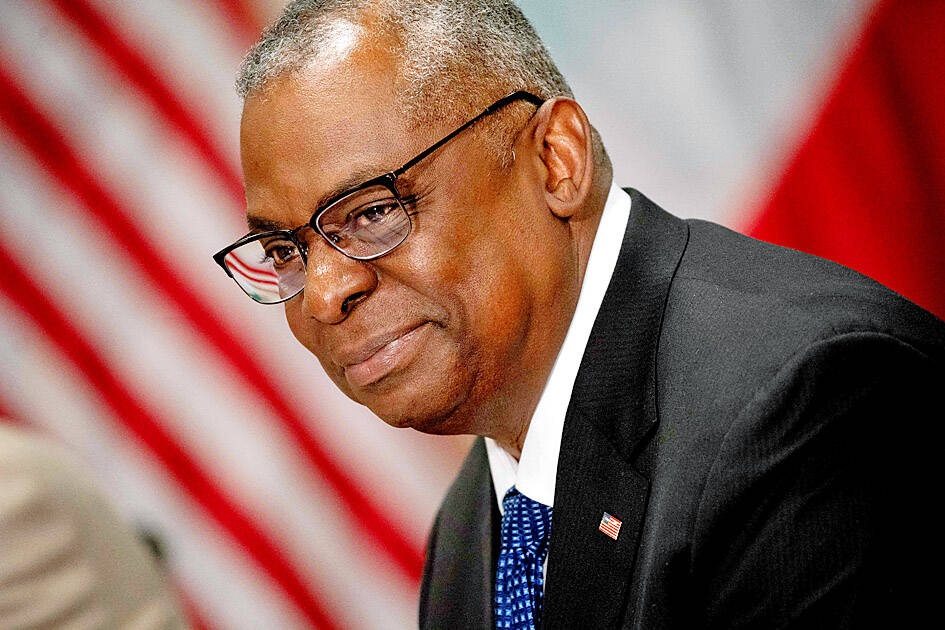US Secretary of Defense Lloyd Austin has prostate cancer, the Pentagon said on Tuesday, after days of silence on his condition, news that was even kept from the White House.
Austin, 70, was admitted to Walter Reed National Military Medical Center in Bethesda, Maryland, on Dec. 22 and underwent surgery to treat the disease, but developed a urinary tract infection a week later and was admitted into intensive care, the Pentagon said.
He remained hospitalized on Tuesday, with US President Joe Biden’s administration finding out the same day, prompting a government-wide review of what protocols are in place to prevent such failures.

Photo: AFP
The Pentagon is scrutinizing its own procedures following the lapse, which left even Austin’s top deputies unaware of his condition for days.
Senior US lawmakers are investigating whether Austin ignored legal requirements to inform the US Congress.
Austin was diagnosed with prostate cancer during a routine screening early last month, but the White House insisted that no one there, including Biden, knew about the diagnosis until Tuesday.
“I think we all recognize — and I think the Pentagon has been very, very honest with themselves — about the challenge to credibility by what has transpired here, and by how hard it was for them to be fully transparent with the American people,” US National Security Council [NSC] spokesman John Kirby said. “We all recognize that this didn’t unfold the way it should have — on so many levels.”
There is no government-wide policy in the Biden administration on how absences of Cabinet officials should be handled, although there is a general expectation that the White House should be made aware of such circumstances, people familiar with the matter said.
The people spoke on condition of anonymity to discuss government practices.
While there is no statutory requirement for public officials in the US to disclose their medical histories, it has become common practice for presidential and vice presidential candidates and incumbents to do so.
Multiple current and former officials said that administrations generally aim to keep close tabs on the whereabouts of the secretaries of state and defense due to their prominent positions in the line of presidential succession, and particularly in the case of the Pentagon.
Cedric Leighton, a retired US Air Force colonel, said that the chain of command for the US military runs from the president through his defense secretary to the combatant commanders, who then execute orders that could include command and control of any potential use of nuclear weapons.
Leighton said it was “imperative” that the president, top administration and military officials, select members of Congress and even key allied counterparts be notified of even a temporary absence.
“It’s highly unusual for any Cabinet secretary not to notify the president, the White House chief of staff, or the NSC of any absence, especially a medical one,” he said.

Former Nicaraguan president Violeta Chamorro, who brought peace to Nicaragua after years of war and was the first woman elected president in the Americas, died on Saturday at the age of 95, her family said. Chamorro, who ruled the poor Central American country from 1990 to 1997, “died in peace, surrounded by the affection and love of her children,” said a statement issued by her four children. As president, Chamorro ended a civil war that had raged for much of the 1980s as US-backed rebels known as the “Contras” fought the leftist Sandinista government. That conflict made Nicaragua one of

COMPETITION: The US and Russia make up about 90 percent of the world stockpile and are adding new versions, while China’s nuclear force is steadily rising, SIPRI said Most of the world’s nuclear-armed states continued to modernize their arsenals last year, setting the stage for a new nuclear arms race, the Stockholm International Peace Research Institute (SIPRI) said yesterday. Nuclear powers including the US and Russia — which account for about 90 percent of the world’s stockpile — had spent time last year “upgrading existing weapons and adding newer versions,” researchers said. Since the end of the Cold War, old warheads have generally been dismantled quicker than new ones have been deployed, resulting in a decrease in the overall number of warheads. However, SIPRI said that the trend was likely

NUCLEAR WARNING: Elites are carelessly fomenting fear and tensions between nuclear powers, perhaps because they have access to shelters, Tulsi Gabbard said After a trip to Hiroshima, US Director of National Intelligence Tulsi Gabbard on Tuesday warned that “warmongers” were pushing the world to the brink of nuclear war. Gabbard did not specify her concerns. Gabbard posted on social media a video of grisly footage from the world’s first nuclear attack and of her staring reflectively at the Hiroshima Peace Memorial. On Aug. 6, 1945, the US obliterated Hiroshima, killing 140,000 people in the explosion and by the end of the year from the uranium bomb’s effects. Three days later, a US plane dropped a plutonium bomb on Nagasaki, leaving abut 74,000 people dead by the

Indian Prime Minister Narendra Modi is to visit Canada next week, his first since relations plummeted after the assassination of a Canadian Sikh separatist in Vancouver, triggering diplomatic expulsions and hitting trade. Analysts hope it is a step toward repairing ties that soured in 2023, after then-Canadian prime minister Justin Trudeau pointed the finger at New Delhi’s involvement in murdering Hardeep Singh Nijjar, claims India furiously denied. An invitation extended by new Canadian Prime Minister Mark Carney to Modi to attend the G7 leaders summit in Canada offers a chance to “reset” relations, former Indian diplomat Harsh Vardhan Shringla said. “This is a